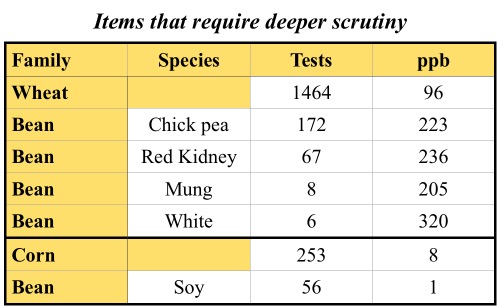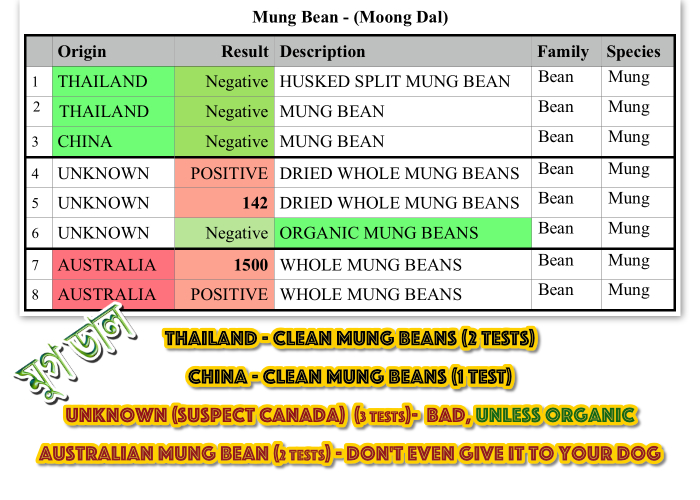Data transcribed from the original CFIA records often shed light on items of great concern, either by their presence or their absence
Food items that are getting more worrisome by their absence from the CFIA test records so far received, and that includes over 7,800 records, are bread, sugar, and cooking oils including Canola.
And then there are food items that are included in the CFIA records, but show test results that are surprising, and points to the need for further investigation.

Above table refers.
Wheat
First item is wheat. As it happens, wheat did not show up in the first couple of thousand test records which are sort of listed chronologically, with the first records being the first batch of samples tested, back in 2015, and the last batches were the most recent tests, going to the end of 2016.
Considering the fact that wheat was mostly being desiccated by glyphosate prior harvest, and therefore is one grain that is expected to have high concentration of the molecule, I was highly surprised by not finding wheat as I began transcribing the data.
However, a few thousand records down the line, wheat started appearing, and in really large number. As expected, glyphosate was present and in much higher concentration than in many other food grains, and especially in comparison with rice.
However, not all foods are clearly marked with the cereal or grain that it is made of. Examples are cookies, biscuits, cake, pasta, pizza and the like. So it became necessary to create additional fields or columns, to describe some of the ingredients the food was made of, in order to properly indicate the probable source of the contamination, if there was glyphosate found in it. Also, the same food was described differently in different samples, including using native non-english names, which had to be translated in these additional columns for clarity and proper grouping.
And so, while glyphosate readings were high based on average, there was now a further need to look through the pile and separate out some primary groups to see which one was too high while another might be low, so that readers and consumers might be able to figure out, even within the Wheat group, which kinds are having more glyphosate than others.
And with the huge test numbers, going over a thousand, there is room for a lot of scrutiny here.
Chick pea and garbanzo beans.
These have been a major surprise as some of their glyphosate readings are through the roof. The table above does not include all the chickpea and most of the garbanzo beans, which are similar to chick pea and at times their names have been interchanged in the product description. In other samples both the terms have been used on the same item.
I came to know from different sources in USA and Canada about the practice of desiccating chickpea and garbanzo crops in USA as well as in Canada is the likely cause of the test results.
This item is linked with a wider group of legumes that fall under the category of lentils. India is a heavy consumer and a large producer of lentils. But its domestic demand is reportedly outstripping its production and India is looking to import more lentils. This may be part of the the reason for industrial scale production of the crops in North America, where the crop is desiccated by glyphosate. According to some scientists, if glyphosate is applied for desiccation, the only real active sink for this systemic chemical to go would be to the seed! Some of the scientists are consulted by farming groups in USA and I am told they would like to pass it on these CFIA findings to the growers for their attention.
Other beans with higher readings
Some of the other beans that will be subjected to greater scrutiny are kidney beans, Mung and white beans. Some have high sampling and test numbers with relatively higher ppb readings, while others have smaller sampling and even higher readings. The main thrust would be to see if one can distinguish these crops from one country to another, and if produce from one place is better than those from another, with regard to glyphosate poisoning. As of now, it looks like certified organic is the only sure way of avoiding much of the glyphosate in this group.
Soy Bean and Corn
This two groups are going to be put to some more scrutiny mainly because their readings are so low. We know of RoundUp ready soy being grown in massive scale in North America, Argentina, Brazil etc. We know of it being used in all kinds of human and animal food, from soy milk to tofu to cattle feed. And yet, the soy based items tested by CFIA is perplexingly devoid of glyphosate. This needs to be investigated. Was the sampling done selectively, or could the method used for detection be faulty and give rise to false negatives and reduced indication of its presence so that it appears to be safe?
We have learned that once glyphosate gets mis-incorporated into animal proteins, it does not show up in spectrograms in its usual place and this can lead to false negatives and erroneous results. We are also learning that the traditional method of using acidulated methanol as a pre-test preparatory procedure is not useful for preparing a sample for testing glyphosate, because while methanol opens up the proteins and releases its glyphosate, that glyphosate reacts with methanol to form compounds that again evade detection, no matter what kind of detection method is applied, i.e. chromatography or ELISA.
I learned that if better methods are used to release glyphosate from these protein compounds, such as proteolysis, then there has been cases of 60 to 120 fold increase in detection of glyphosate.
If that argument is true for animal proteins, could they also be true for plant proteins, especially with regard to soy and corn ? These are areas that I would like to be further educated by scientists.
Also, some of my future correspondence with the Canadian Government might including finding out what methods the labs used for detection of glyphosate in proteins.
Just like Soy Beans, we also know about RoundUp ready Corn and corn being the base ingredient in a very wide range of foods. CFIA has several hundred tests done on hundreds of corn based foods and yet, the average reading is very low.
This is puzzling and needs more scrutiny.
These are preliminary indication of work to do, as far as information can be gathered, on these issues.
Comments welcome.

